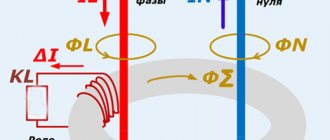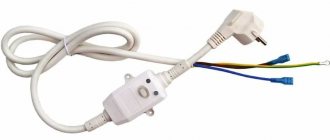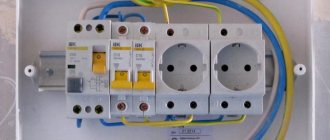Normal distribution of potentials in sockets
Two phases in a socket
Before you figure out why there are two phases in sockets at once, you should know that a pair of supply wires are supplied to the apartment along the electrical wiring line, one of which is called phase, and the second is called zero. The potential of 220 Volts operates only on one of the socket terminals, and on the second it is zero. You can verify this by using a regular indicator screwdriver.
The presence of two potentials (phase and zero) is a prerequisite for the operation of any power supply system.
If the socket does not have one phase or for some reason the zero is missing, it will not be possible to obtain the difference between their values (220-0 = 220 Volts), called voltage. Therefore, if the zero in the sockets is missing, and you don’t know how to find it, before starting the search you should familiarize yourself with the principle of potential formation. The situation is much more complicated when, instead of zero, another phase appears on the second terminal. To eliminate this problem, you will need to understand the reasons for its occurrence.
How the voltage indicator works: a brief explanation
To check the phase potential, place the tip of the screwdriver indicator into the socket of the socket being tested, and touch the free contact socket on its body with your finger.
A high-resistance resistor and a neon light bulb or LED are mounted in series inside the indicator. A current-limiting resistance reduces the current through this chain to a value that is safe for the human body, but sufficient for the indicator to glow.
Further along the arm, body and shoes, the current flows to the ground and returns through it to the transformer substation, forming a closed circuit.
If the indicator touches the potential of the neutral wire, then its very small value will not be able to cause the indicator light to light up, which is the main reason to declare that there is no dangerous voltage on it.
However, in practice there are situations when, when faults occur in household wiring, working with a capacitive voltage indicator, the home master notices a dangerous potential where, in his opinion, it cannot possibly exist.
Reasons for the appearance of two phases
Two phases in the socket when the neutral wire is broken.
The appearance of a phase on two wires at once can be explained by the following combination of circumstances:
- A break in the neutral wire in the input panel of a house or apartment.
- It is damaged at the input or inside the junction box.
- Contact failure in the “zero” connection in only one socket.
- Short circuit of the phase wire to the neutral conductor due to insulation damage.
To understand why the indicator shows the phase on both wires at once, the reason that caused each of these phenomena will need to be considered separately.
If there is no zero in the socket, first of all you should find the place where it disappears (break). A possible option is damage to the cable at the entrance to the house or apartment, as a result of which the “zero” will disappear in all sockets installed inside the building and in individual rooms. In addition, the contact can be broken anywhere in the electrical circuit, including at the input or inside the distribution box, which will lead to the malfunction of only a few sockets.
The second case concerns those of them that are connected within the room to this particular distribution node (that is, approximately half), and in all other installation products the normally working “zero” will remain.
If there is a fault only at the input to a specific socket, the disappearance of zero and the appearance of the second phase will be observed only in it. In order for the situation under consideration to form completely - voltage reaches the broken neutral contact - it will be necessary for the exposed phase wire to accidentally short-circuit to it.
A variation of the latter case is when the neutral wire is not broken, but the phase wire with damaged insulation is shorted to the ground contact. This will also lead to the appearance of two high potentials in this outlet at once.
Purpose of the neutral conductor
Some people mistakenly think that zero is only ground. In fact, it performs the function of connecting the neutrals of electrical appliances in a three-phase circuit.
When different loads are applied to all phases, they shift, or rather the neutral shifts. This breaks the symmetry of stresses. One consumer of electricity is supplied with too much electricity, while another is supplied with too little and insufficient electricity. In the first case, electrical installations may overload and burn out, and in the second, they may not work correctly, fail, etc.
For your information! The main purpose of the neutral conductor is to create a circuit for short circuit current. It has too little resistance, and the current value must be such that the protection responds quickly, disconnecting the damaged electronics from the network.
Possible consequences and danger of the appearance of two phases
Two phases in an outlet give zero potential difference
When there are 2 phases in a particular outlet, you must first of all worry about what this threatens for the people using it. This situation is unacceptable for the following reasons:
- The potential difference between the socket terminals will be 220-220=0 Volts.
- The voltage will be lost and connected household appliances will not work.
- A danger arises due to the loss of the protective grounding circuit, which in old houses operates through an earthen conductor (due to the lack of a local circuit).
In this case, there is no need to talk about any protection at all; the consequences may be unacceptable to people. An ignorant electrician, believing that he touches the neutral wire (in blue insulation), may find himself under high voltage. Therefore, the regulatory documentation requires that when disassembling installation products, it is imperative to check the absence of a phase on both terminals using an indicator.
In this situation, all or only the light switches connected to this junction box will also stop working. This is explained by the fact that a phase potential will appear on the neutral wire supplied to the chandelier, connected to the corresponding contact of the socket, and the voltage difference will become zero.
Connecting a chandelier with your own hands
A seemingly simple operation - installing a new chandelier - can confuse a person unfamiliar with electrics: there are a lot of wires and it is not clear what to connect to what. We will discuss how to connect a chandelier with a different number of arms (and wires) to a switch.
Preparation: continuity testing and phase determination on the ceiling
Those who have at least a little knowledge of electrical networks will not need this, others will find it useful. It can be difficult for a person who does not constantly deal with electricity to navigate. To avoid confusion, we will tell you everything in order: how to find phase (or phases) and zero in the wires on the ceiling, what to do with grounding. And then, like a whole bunch of wires on a chandelier, connect them to those that stick out above. As a result, connecting the chandelier with your own hands will be a simple task for you.
Ground wire
If the wiring is already done, there will be two, three or four wires sticking out from the ceiling. One of them is definitely “zero”, the rest are phase, and there may also be grounding.
There is a grounding wire in houses that are newly built or recently renovated.
There is not always a grounding wire, only in newly built houses or after major renovations with replacement of electrical wiring. According to the standard, it has a yellow-green color and is connected to the same wire on the chandelier. If your chandelier does not have one, carefully insulate the exposed wire and leave it as is. You cannot leave it uninsulated - you may accidentally short-circuit it.
Looking for phases and zero
You need to figure out the rest of the wires: where is the “phase” and where is the “zero”. In older houses, all wires are usually the same color. Most often - black. New buildings may have black and blue, or brown and blue. Sometimes red is present. In order not to guess by colors, it is easier to ring them.
If you have three wires on the ceiling, and a two-key switch on the wall, you should have two “phases” - for each of the keys and one “zero” - the common wire. You can ring with a multimeter (tester) or an indicator screwdriver (this is a special screwdriver with a light that lights up when voltage is present). During operation, move the switch key to the “on” position (the input circuit breaker on the panel is also turned on). After dialing, turn the switch keys to the “off” position. If possible, it is better to turn off the circuit breaker on the panel and connect the chandelier with the power turned off.
Checking the wires on the ceiling with a tamper
How to ring and identify wires with a tester is shown in the photo. Set the switch to the “volts” position, select the scale (more than 220 V). Alternately touch the pairs of wires with the probes (hold the probes by the handles, do not touch the exposed conductors). The two phases do not “ring” with each other - there will be no changes on the indicator.
If all the wires are the same color, mark them somehow: with paint, a colored marker, or a piece of adhesive tape. Phases are in one color, zero is in another.
It is easier to work with an indicator screwdriver: just touch its end to the exposed conductor. Lit - phase, no - zero. Very simple.
Using an indicator screwdriver to find a phase
If there are only two wires sticking out, then one of them is phase, the other is zero. In this case, there is only one key on the switch. There are no other options.
Read about the rules and methods for connecting wires in a junction box here.
Recommendations for troubleshooting
Examples of zero breaks
If there are two high potentials at the terminals of old-style sockets (2 phases and grounded zero - for new installation products with three contacts) - this situation requires urgent intervention. Since it is associated with a break in the neutral core, you first need to find the exact location of the damage using visual inspection methods plus the necessary tools. To do this, you will need to take actions depending on the nature of the damage.
When the problem affects all sockets in the residential premises of an entrance hall or a specific apartment, you should call an electrician who has access to the distribution cabinet and the input circuit breaker. If the malfunction is observed only in the apartment (on one/several distribution boxes or in a separate outlet), it is possible to fix it yourself. To do this you will need to perform the following operations:
- Turn off the input circuit breaker, located in the common corridor and supplying voltage to the entire apartment.
- Inspect the junction box, at the input of which or inside there is supposedly a fault hidden.
- If an obvious break (poor contact) is detected in the wire entering or leaving the box, it is necessary to restore the broken circuit using a simple tool - a soldering iron or a screwdriver.
- If the fault appears only on one of the sockets, you should remove its cover and carefully examine all contacts.
- If you find a loose fastening on the zero terminal, you must tighten it using a screwdriver.
In order for the second phase to disappear from the sockets and the chandelier to start burning again, you will also need to isolate the damaged phase core from the already restored “zero”.
Only if you follow the appropriate instructions can you eliminate the detected fault observed in all, half or only one socket. The appearance of two phases, regardless of the total number of sockets involved, most often occurs when the rules for using household electrical products are violated.
Break of zero at the input
If the zero wire in the incoming cable is disconnected, the lights in the apartment will go out and electrical appliances will stop. Checking with an indicator will show the presence of a phase on each contact of the socket. The classic question arises: “Who is to blame and what to do?”
In the absence of zero, the current searches for a free line. If the lamp is turned on, it does not light, but the phase passes through the filament to the neutral wire, then to the bus, and from there to the neutral line of sockets. The phase can also come from a device connected to any plug connector in the apartment. Now there is a phase on each socket of the socket. The indicator emits a light signal when each contact is touched.
A multimeter helps to easily clarify the situation. If you measure the voltage difference between two phases, the device will show a zero value. It is clear that this is the same phase. It is enough to turn off the lamps and disconnect the devices from the sockets and the second phase in the socket will disappear, because the voltage and neutral supply lines do not have other connection points.
It is necessary to restore the incoming zero line. It is possible that the wire has simply become disconnected from the bus. This problem can be dealt with even at home. De-energize the apartment by opening the phase input and check the absence of voltage. Insert the neutral lead into the terminal and tighten the screw.
Breakage of the neutral wire in the junction box or in the wall
Sometimes a zero break occurs in the junction box. In this case, part of the apartment's wiring is functioning normally, but the line connected to this box is inoperative. It is enough to find where the zero broke off or burned out and restore the connection.
It happens that two phases appear in the plug connector due to damage to the neutral wire inside the wall. The cause of the malfunction is negligence when drilling holes. If you break the insulation by breaking through the wire, the neutral conductor will be welded to the phase conductor. In this case, there will also be two phases in the outlet. It is necessary to lay a new line or open the damaged area and repair the wiring.
Summarizing
In case of wiring faults caused by local loss of zero in the electrical panel or on internal wiring lines, the fault can be corrected independently. The presence of voltage at the faulty socket should be checked with an indicator; if its light is on at each contact, then most likely the zero has disappeared. To verify this, it is enough to measure the voltage between zero and phase of the plug connector.
In older TN-C systems, where only 2 wires are used for wiring, there is no wiring grounding, so such accidents can pose a serious threat to life.











